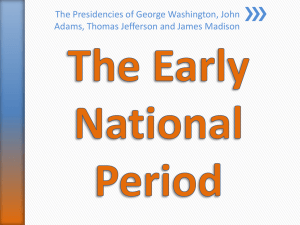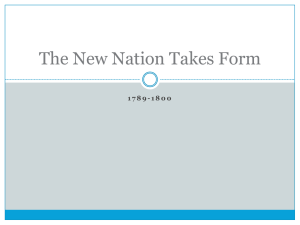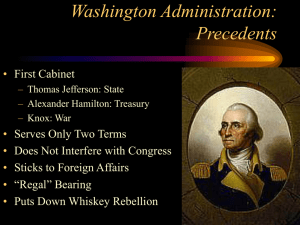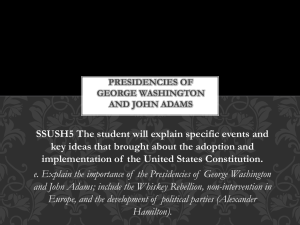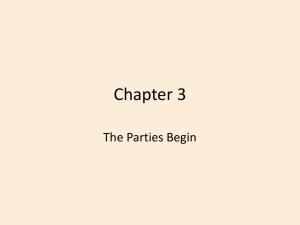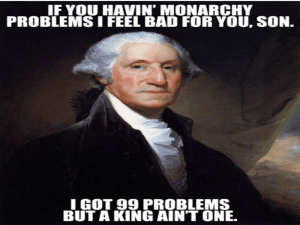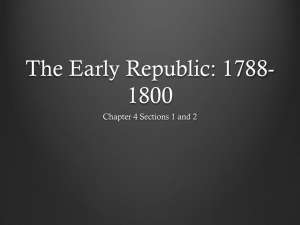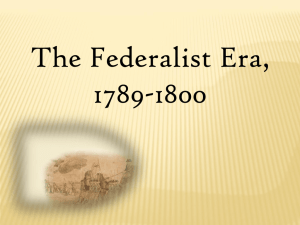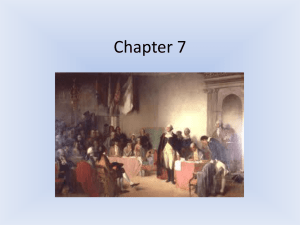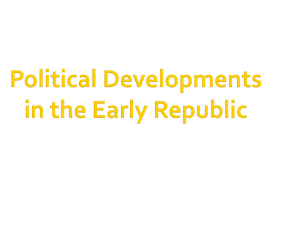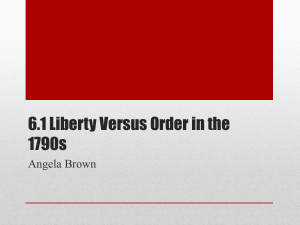Regular PowerPoint - Bremerton School District
advertisement
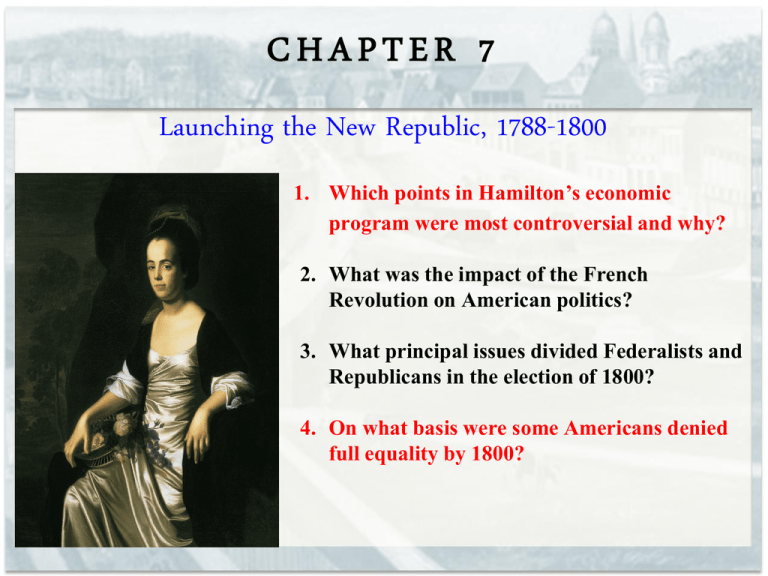
CHAPTER 7 Launching the New Republic, 1788-1800 1. Which points in Hamilton’s economic program were most controversial and why? 2. What was the impact of the French Revolution on American politics? 3. What principal issues divided Federalists and Republicans in the election of 1800? 4. On what basis were some Americans denied full equality by 1800? Constitutional Government Takes Shape, 1788-1796 Implementing Government 1789 – George Washington becomes president; John Adams becomes vice president Although there technically weren’t any political parties yet – many consider them both to be Federalists Washington was inaugurated in the capital city (from 1788-1790) of New York Constitutional Government Takes Shape, 1788-1796 The Federal Judiciary and the Bill of Rights The Judiciary Act of 1789 set up the federal court system In 1791, the Bill of Rights (First 10 Amendments) were ratified Hamilton’s Domestic Policies, 1789-1794 Establishing the Nation’s Credit Alexander Hamilton (Sec. of the Treasury) issued to Congress his Reports on the Public Credit (1790) National Debt = $54 million + $25 million debt owed from the states His plan: • • • • Pay off the $12 million of foreign debt ASAP Keep the debt owed to Americans (to unite the wealthy to the government) Pay off the interest to this debt with import taxes and an excise tax on whiskey “Fund” this debt through bonds and Western land sales • The poor (in need of money) already cashed in their bonds for less value • The rich who kept theirs stood to gain – the rich get richer • Assume the state debts (mostly already paid only by the South) • This benefited the “irresponsibility” of the procrastinating North • To make this happen and appease the South, Hamilton agreed to move the nation’s capital to the South (Philadelphia – then later to Washington D.C.) Hamilton’s Domestic Policies, 1789-1794 Creating a National Bank Hamilton wanted to create a National Bank: • Depository for federal tax revenue • Loan $ to the government • Issue national currency • Regulate state-chartered banks • Provide credit to expand our nation’s economy Thomas Jefferson (Sec. of State) and James Madison (Congressman) disapproved… • The rich would invest and gain interest – the rich getting richer • The needy poor would take out loans and pay interest – the poor would pay the rich! Jefferson and Madison argued to G. Washington that it was unconstitutional because the Constitution didn’t say that a National Bank could be created = STRICT INTERPRETATION Hamilton argued that it was constitutional because the Constitution said that Congress can enact all measures that are “necessary and proper” = LOOSE INTERPRETATION Washington agreed with Hamilton, Congress barely passed the measure, and in 1791 Washington signed the bank bill for a 20-year charter Hamilton’s Domestic Policies, 1789-1794 Emerging Partisanship Although there were no formal political parties… two distinct parties began to emerge… Federalists: Republicans: Rich Poor Northerners Southerners Easterners Westerners Pro-British Pro-French Hamilton, Washington, and Adams Jefferson and Madison 1792 – Washington and Adams are reelected as president and vice president Hamilton’s Domestic Policies, 1789-1794 The Whiskey Rebellion Hamilton’s excise tax on whiskey is becoming excessively burdensome on western Pennsylvanian farmers who have to convert their grain to alcohol for more efficient transportation. 1794 – Western Pennsylvanians have had enough and revolt against U.S. Marshalls serving court summons. Washington gathers 13,000 militiamen who quickly suppress the rebellion The old ways of rebellion are over and people must obey the new Constitution The United States in a Wider World, 1789-1796 Spanish Power in Western North America More of the same for Spain… missions, trading, forts, and wiping out the Native Americans with disease The United States in a Wider World, 1789-1796 Challenging American Expansion, 1789-1792 The area between the Appalachian Mountains and the Mississippi River were wanted by the Indians, the Spanish, the Americans, and the British (who couldn’t just let it go) To help their claims, America added Vermont (not in the West), Kentucky, and Tennessee as states The United States in a Wider World, 1789-1796 France and Factional Politics, 1793 1789: • • • • The French Revolution broke out… Americans were split on their support After the French declared war on Spain and Britain, the South and West wanted a French victory to hopefully get the Spanish and British to stop inspiring the Indian resistance in the West The Northeastern merchants supported Britain and her money (via trade) French ambassador Genet got some Americans to fight with the French In 1793, Washington issued a statement of U.S. neutrality The United States in a Wider World, 1789-1796 Diplomacy and War, 1793-1796 The British didn’t like America’s “friendliness” to the French, so they began seizing our ships, impressing our crewmen, and inciting the Ohio Valley Indians “Mad Anthony” Wayne won the Battle of Fallen Timbers which led to the Treaty of Greenville opening up the Ohio Valley for U.S. settlement The United States in a Wider World, 1789-1796 Diplomacy and War, 1793-1796 Jay’s Treaty (1795): Got the British to abandon their American forts (weren’t they supposed to after the Revolution?) … but, it didn’t mention British impressment of our seamen Pinckney’s Treaty (1796): Settled the northern border of Spanish Florida and Spain opened up the Mississippi River (and New Orleans) to the Americans Parties and Politics, 1793-1800 Ideological Confrontation, 1793-1794 The Federalists were suspicious of the people having too much power (democracy) due to events like the French Revolution and the Whiskey Rebellion Hamilton Washington Adams The Jefferson Republicans trusted the people, but feared having the government run by just a few elite individuals Jefferson Madison Parties and Politics, 1793-1800 The Republican Party, 1794-1796 Newspapers grew in circulation and printed much political mudslinging Washington decided not to run in 1796 and gave his farewell address… • Political parties are bad for the U.S. • Stay out of foreign entanglements (European politics) Parties and Politics, 1793-1800 The Election of 1796 With a 71-68 majority in electoral Votes, John Adams (Federalist) becomes our second president With the second-most electoral votes, Thomas Jefferson (Republican) becomes our second vice president Parties and Politics, 1793-1800 The French Crisis, 1798-1799 In response to the British-friendly Jay’s Treaty, the French began seizing American ships. This eventually led to what becomes known as the… XYZ Affair This caused Adams to arm our ships and build up our military as we fought an undeclared Quasi-War against France. Parties and Politics, 1793-1800 The Alien and Sedition Acts, 1798 The Federalist Congress passed these acts in 1798 for our protection… Mainly they were used to weaken and/or silence the Republican party The Sedition Act was to expire in 1801 (in case the Feds lost the 1800 election) Virginia and Kentucky (anonymously supported by Madison and Jefferson) wanted nothing to do with these acts! Parties and Politics, 1793-1800 The Alien and Sedition Acts, 1798 A summary of John Adams’ presidency Parties and Politics, 1793-1800 The Election of 1800 Noteworthy election because… • First time political parties have played a major role • First time we had a major power shift in the executive branch • We didn’t collapse as a nation into a civil war • There was a tie Economic and Social Change Producing for Markets After the Revolutionary War, Americans began to produce goods for sale (market economy) rather than just for themselves (subsistence) Most would work from home instead of “going to work”, sometimes referred to as the putting-out system Economic and Social Change White Women in the Republic After the Revolutionary War, the roles for white women didn’t advance too much… • Got to pick their husbands or use pregnancy to force the issue • Granted more divorces • Had fewer kids The concept of Republican Motherhood avowed that white women should be educated… but only to raise their children as virtuous little citizens Economic and Social Change Land and Culture: Native Americans Native Americans had it bad… • Land was often taken/stolen from them • Disease and fighting killed off huge portions of their tribes • U.S. government tried to “civilize” them • Many became addicted to alcohol • Their culture was slowly being destroyed Economic and Social Change African-American Struggles The advancements made by blacks after the Declaration of Independence were short-lived as life worsened (politically, economically, and socially) for all blacks Whites were anxious after the successful Haitian slave revolution and the attempted revolution in Richmond, VA (Gabriel’s Rebellion) in 1800 There were a few “successes” such as Benjamin Banneker and the creation of The AME church 1793 – Eli Whitney’s cotton gin makes slavery a profitable investment in the South
